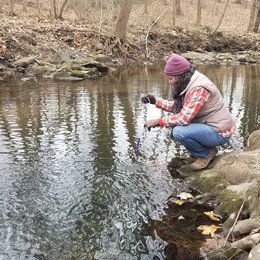
One Drop at a Time
Small changes at home can make a big difference in reducing the damaging effects of storm water.
“Environmental stewardship begins in the home,” says Mary-Margaret Monser, an Ambler resident with a deep-seated love of the natural world.
It would be tough to find a better environmental steward than Monser. She supports a number of organizations devoted to protecting and preserving the environment, such as the Wissahickon Valley Watershed Association. In addition, she chairs the Ambler Environmental Advisory Council, which devotes its time and energy to assisting public officials in the protection, conservation, and management of Ambler’s natural resources. This includes programs to reduce stormwater runoff that can threaten the health of local waterways such as the Wissahickon.
For those who are uneducated about the perils of storm water, Monser says it poses a formidable threat. In urban or semi-urban neighborhoods, impervious surfaces such as roads, driveways, and patios cover much of the soil, meaning storm water flows directly into the sewers that feed creeks and other waterways. Along the way, the storm water picks up motor oil, fertilizers, and other pollutants, not to mention trash, which can wreak havoc on waterways and, in turn, make it unsafe for humans to swim in or fish from, let alone drink.
Through a program known as “Growing Ambler Greener: Clean Streams, Clean Water,” Ambler residents can learn how to improve the health of waterways, as well as beautify their properties. For example, residents can install a number of stormwater features: a rain garden to absorb water from a home’s roof or other impervious surfaces; a rain barrel to collect water for nourishing nonedible plants, thereby reducing runoff and also decreasing water consumption; landscaped downspout planters, which absorb and filter stormwater before it flows to nearby sewers; and permeable pavers specially designed to allow water to soak into the soil below.
“We want people to keep all the water on their property,” says Monser, who also works as a nurse anesthetist at Einstein Medical Center Montgomery in East Norriton. “It’s about adjusting our mindset and starting a culture change so we can protect our planet a little better. Every one of us has a part to play.”
Monser has done her share. She has a rain barrel at her home that provides “thirsty plants” with easy access to water. She’s also in the process of installing a rain garden at a rental property. But her contributions stretch far beyond her property lines; she was the primary impetus behind the Clean Streams, Clean Water program.
Monser, for her part, gives much of the credit to Susan Curry, her predecessor as EAC chair. When Monser took the reins, she had been working with Ambler Borough to establish a tidy budget to fund stormwater-management programs. The potential for funds evaporated, however, so she had to find another way.
Despite the fact that she had no prior grant-writing experience, she applied for a Growing Greener grant through the Pennsylvania Department of Environmental Protection. The good news came in December 2017, almost a year after she applied for the grant, when the state came through with $206,000 to support her passion project.
What this means: Through December 2020, Ambler residents and businesses can receive funds to become “a solution to the pollution” in local waterways by installing stormwater features. In addition, the EAC is providing free educational workshops on stormwater features in February, March, and April. (For a workshop schedule, visit GrowingAmblerGreener.com.)
Monser says her family instilled in her a love of the outdoors—particularly her mother, who was “a fiercely independent woman.” As a child, Monser and her family spent time at the likes of Prince William Forest Park on the banks of the Potomac River, in the forests of Otego, N.Y., along the Susquehanna River, and in Fort Washington State Park. In turn, Monser has passed her love of the natural world on to her children.
As Monser looks to the future, she is heartened by the dedication of her fellow EAC volunteers, as well as by the next generation of environmental stewards, including students from nearby Upper Dublin High School and Penn State Abington. At the same time, she admits to feeling a sense of unease about what’s to come.
“I feel like we’re right at the cusp of this momentous moment, because there’s a lot more awareness among people who have an interest,” she says. “I also worry that clearly we [as a species] are not investing enough time or energy into preserving our planet. … The good news is that change starts with one person who is willing to do something about it.”
Photograph courtesy of Mary-Margaret Monser


